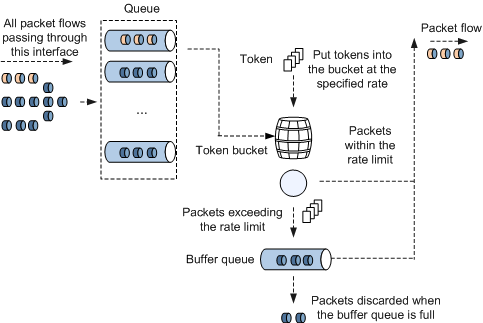Interface-based Rate Limiting
Interface-based rate limiting controls the total rate of all packets sent or received on an interface.
Interface-based rate limiting uses the token bucket mechanism to control traffic rates. If rate limiting is configured on an interface, all packets passing through this interface must be processed by the token bucket. If there are sufficient tokens in the token bucket for packet forwarding, packets are sent out from the interface. Otherwise, packets are discarded or buffered.
Interface-based rate limiting can be configured in the inbound or outbound direction. This section focuses on interface-based rate limiting in the outbound direction.
Process
The following example illustrates the process of interface-based rate limiting in the outbound direction of an interface using the single-rate-single-bucket mode.

The interface-based rate limiting process is as follows:
- If there are sufficient tokens in the bucket, the system sends the packets and decreases the number of tokens accordingly.
- If tokens in the bucket are insufficient for packet forwarding, the system places the packets into the buffer queue. If the buffer queue is full, the system discards the packets.
- When there are packets in the buffer queue, the system compares the number of packets with the number of tokens in the token bucket. If there are sufficient tokens, the system forwards packets until all the packets in the buffer queue are sent.